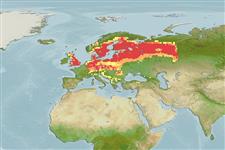Classification / Names
Common names from other countries
Main reference
Size / Weight / Age
Max length : 25.0 cm TL male/unsexed; (Ref. 556); common length : 12.0 cm TL male/unsexed; (Ref. 556); max. published weight: 400.00 g (Ref. 556); max. reported age: 10 years (Ref. 59043)
Length at first maturity
Lm 10.5 range ? - ? cm
Environment
Freshwater; brackish; demersal; pH range: 7.0 - 7.5; dH range: 8 - 12; potamodromous (Ref. 51243); depth range 10 - ? m (Ref. 9696)
Climate / Range
Temperate; 10°C - 20°C (Ref. 13371), preferred ?; 74°N - 43°N, 6°W - 169°E
Distribution
Europe: Caspian, Black, Baltic and North Sea basins; Great Britain; north to about 69° N in Scandinavia. Asia: Aral Sea basin, Arctic Ocean basin eastward to Kolyma drainage. Several countries report adverse ecological impact after introduction.
Countries | FAO areas | Ecosystems | Occurrences | Introductions
Short description
Dorsal
spines
(total): 11 - 19;
Dorsal
soft rays
(total): 11-16;
Anal
spines: 2;
Anal
soft rays: 5 - 6;
Vertebrae: 35 - 36. Distinguished uniquely from its congeners by its body depth 24-27% SL. Differs further from other members of the genus by the combination of having a flank yellowish with numerous, small, irregular, dark blotches and having 11-16 dorsal spines (Ref. 59043). Caudal fin with 16 to 17 rays (Ref. 40476). Dorsal fins are fused. Color brownish with dark spots (Ref. 35388).
IUCN Red List Status (Ref. 115185)
Threat to humans
Potential pest
Human uses
Fisheries: minor commercial; gamefish: yes; bait: usually
Tools
Special reports
Download XML
Internet sources
Estimates of some properties based on models
Phylogenetic diversity index
PD50 = 0.5312 many relatives (e.g. carps) 0.5 - 2.0 few relatives (e.g. lungfishes)
Trophic Level
3.3 ±0.57 se; Based on food items.
Resilience
Medium, minimum population doubling time 1.4 - 4.4 years (K=0.1-0.48; tm=1-2)
Vulnerability
Low vulnerability (20 of 100)
Price category
